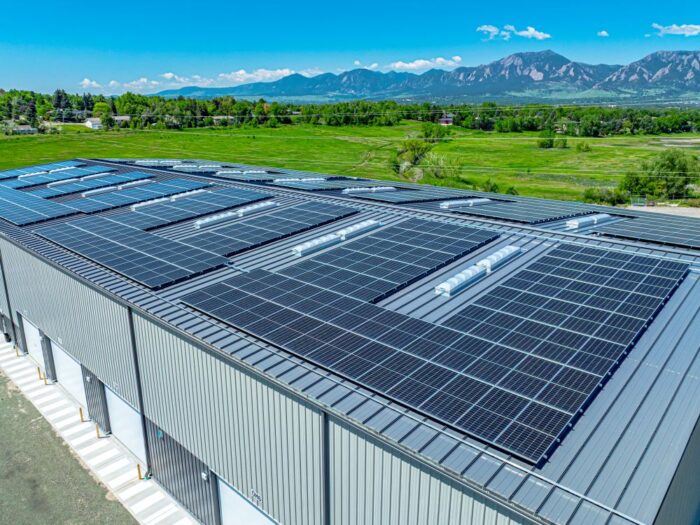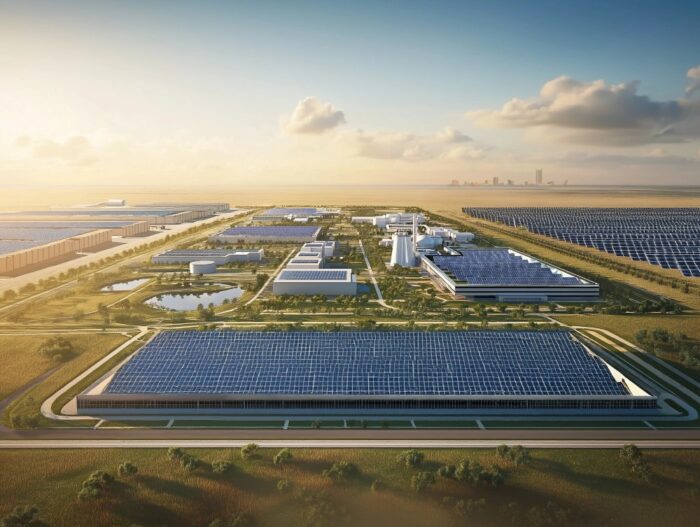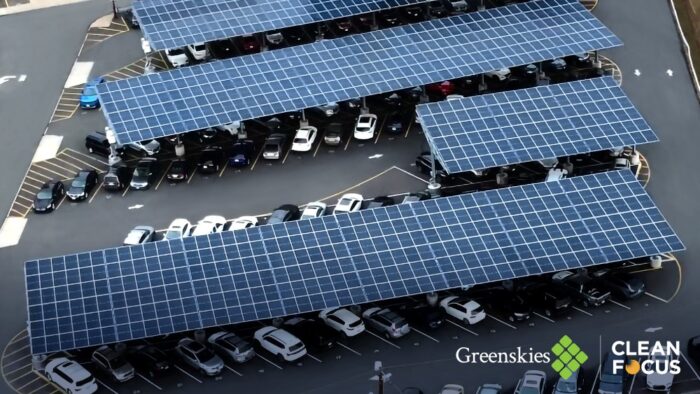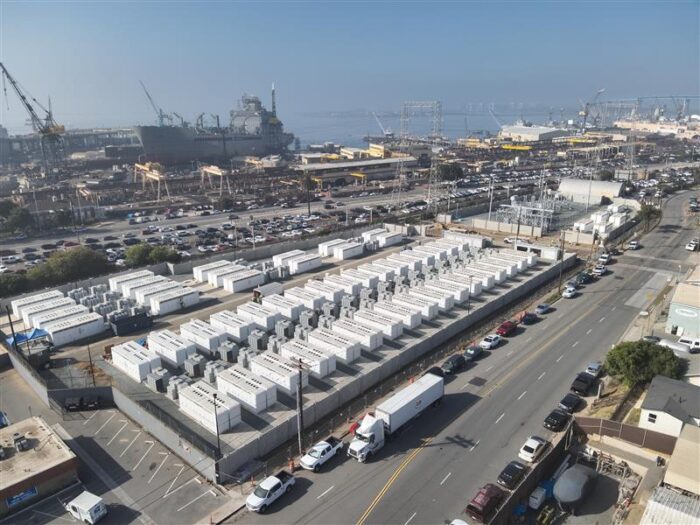Namaste Solar teams with Boulder, Colo. | Projects Weekly

Namaste Solar partnered with the city of Boulder, Colorado, to install a 333.54 kW flush-mount rooftop solar system at a modular home factory. Fermi America is seeking to build a massive “HyperGrid” to power AI data centers in Texas. Greenskies Clean Focus completed a 1.62 MW solar portfolio for Hackensack Public Schools in New Jersey. The Ohio Power Siting Board approved the proposed 120 MW Frasier Solar project in Knox County. RWE has commissioned its first energy project in Kentucky, with the 86 MW Ashwood Solar facility. Arevon began operations at its 200 MW Peregrine Energy Storage project in San Diego. Read all the details in this edition of Projects Weekly.
Namaste Solar has partnered with the city of Boulder, Colorado, to install a 333.54 kW solar system a modular home factory in the city. The company installed a flush-mount rooftop solar system at Boulder Mod. The factory is a partnership between the city, Boulder Valley School District and Flatirons Habitat for Humanity, which produces energy-efficient, all-electric modular homes that are permanently affordable for low- to middle-income (LMI) households. This facility is at the forefront of addressing two critical community needs: affordable housing and climate action.
“This project exemplifies the powerful intersection of renewable energy and community development,” said Jay Sugnet, senior planner for the City of Boulder and project manager for the modular home factory. “By integrating solar energy into Boulder Mod, we’re not only reducing our carbon footprint but also supporting the production of affordable, energy-efficient homes that our community urgently needs.”

Cool factor: By powering the all-electric Boulder Mod factory with solar energy, this project directly supports the city’s comprehensive Climate Action initiatives and reduces operational costs for the facility. Boulder is committed to achieving a 70% reduction in greenhouse gas emissions by 2030 and becoming a net-zero city by 2035. The system is designed to offset the factory’s total expected electricity consumption, ensuring that every dollar saved on energy is reinvested in Boulder’s mission to expand affordable housing.
The Boulder Mod solar installation was made possible in part through the Inflation Reduction Act (IRA) of 2022, which created new incentives for clean energy adoption. One of the most significant changes for municipal governments has been the introduction of elective pay (also known as direct pay), enabling local governments to access tax rebates for clean energy projects, even as non-taxable entities. Through elective pay, combined with additional payments from Xcel Energy’s Solar*Rewards C&I Income-Qualified and Disproportionately Impacted Communities program, Boulder was able to maximize the financial benefits of installing solar at this critical facility. The project received $333,540.00 as a grant from the Energy Impact Offset Fund, an ordinance that requires cannabis cultivators to offset 100% of their energy use.
“Municipalities have more options than ever to leverage solar energy to reduce costs and protect against rising energy expenses,” said Rachel Mountain, Co-owner and Director of Commercial Sales at Namaste Solar, an employee-owned solar cooperative and Certified B Corporation. “This project is a shining example of how renewable energy can empower cities to achieve their climate goals while supporting innovative programs like Boulder Mod. It’s a win-win for the community and the environment.”
Fermi America joins Texas Tech to build largest data energy complex
Fermi America is seeking to develop next-generation electric grids that deliver redundant power at gigawatt scale to power artificial intelligence data centers. Cofounded by former U.S. Secretary of Energy and Rick Perry, the company is building a first-of-its-kind behind-the-meter “HyperGrid” campus that is expected to integrate the largest nuclear power complex in the United States, along with the country’s biggest combined-cycle natural gas project, utility grid power, solar power, and battery energy storage to deliver next-generation AI.
“The Chinese are building 22 nuclear reactors today to power the future of AI,” said Perry, who also served as Texas governor from 2000 to 2015. “America has none. We’re behind, and it’s all hands on deck.”
Geotechnical work has already begun on the campus which is expected to deliver 1 GW of online power by the end of 2026.

Cool factor: Located in Amarillo, Texas, in partnership with the Texas Tech University System, this ambitious project is expected to be the world’s largest energy-driven AI complex. Spanning 5,769 acres, the campus has the potential to deliver up to 11 GW of power and 18 million square feet of artificial intelligence capacity.
Strategically situated at the confluence of several of the nation’s largest gas pipelines and located atop one of the nation’s largest known natural gas fields, the site offers a prolific, firm, clean-burning and redundant gas supply. Leveraging the campus’s proximity to Pantex, the nation’s primary nuclear facility that has successfully stewarded the U.S. nuclear arsenal since 1951, underscores Fermi’s strategic position to build clean, safe, new nuclear power for America’s next-generation AI. The site also boasts some of the nation’s fastest premier fiber infrastructure and prime solar resources. Purpose-built for AI and data, the HyperGrid is expected to deliver clean, highly reliable base-load power at unprecedented scale.
Greenskies completes 1.62 MW solar portfolio for N.J. school district
Greenskies Clean Focus has completed a 1.62 MW portfolio of solar energy projects for the Hackensack Public Schools (HPS) in New Jersey.
“This project exemplifies how school districts can harness solar energy to achieve both financial and environmental goals,” said Bryant Bernhardt, senior VP of business development at Greenskies.
The portfolio includes eight solar systems installed across seven sites, including all four elementary schools, the middle school, the high school, and the board of education administration building. While most systems were installed on rooftops, Hackensack High School features a combination of rooftop and carport solar arrays. Together, these systems encompass more than 3,600 solar panels.

Cool factor: Greenskies served as the solar developer, EPC, financer, and owner for the projects and will manage long-term operations and maintenance. The installations were funded through a 15-year solar power purchase agreement (PPA), allowing HPS to benefit from clean energy with no upfront investment.
“By transitioning to renewable energy, we’re reducing our environmental footprint and creating long-term cost savings that can be reinvested directly into our classrooms,” said Assistant Superintendent Andrea Parchment. “We’re also providing our students with real-world examples of innovation and sustainability in action. Every day they walk into school, they’ll see firsthand how smart energy choices can power both education and environmental responsibility.”
The eight installed solar systems include:
- Hackensack High School – 1 MW combined
- Hackensack Middle School – 303 kW
- Nellie K. Parker School (Elementary) – 113 kW
- Jackson Avenue School (Elementary) – 70 kW
- Fanny Meyer Hillers School (Elementary) – 41 kW
- Fairmount School (Elementary) – 24 kW
- Padovano Center (BOE Administration Building) – 65 kW
Ohio regulators approve Frasier Solar project
The Ohio Power Siting Board (OPSB) approved the proposed Frasier Solar project, granting its Certificate of Environmental Compatibility and Public Need. Developed by Open Road Renewables, the 120 MW project will be located in Clinton and Miller townships and the city of Mount Vernon in Knox County, Ohio.
“This project reflects our deep commitment to working hand-in-hand with farmers, government officials, and the local community to deliver significant, long-lasting benefits,” said Craig Adair, VP of development at Open Road Renewables. “From new jobs to stable income for local farmers to millions in new revenue for Mount Vernon schools and county services, we’re proud to be a part of Knox County’s future and excited to help meet Ohio’s rapidly growing energy needs with reliable, homegrown power.”
The project will require more than 200 construction workers, plus an additional 3-5 long-term employees during operation. Thanks to the PILOT agreement approved by the Knox County Board of Commissioners in 2023, once operational, the project will deliver up to $42.8 million in stable, new revenue to the local community over the project’s lifetime, including up to $19.4 million to the Mount Vernon City School District. Funds of up to $1.1 million per year will go to various Knox County taxing jurisdictions.
Cool factor: Frasier Solar will use sheep grazing for vegetation management at the project site, ensuring the approximately 800-acre project area will remain in agricultural use while producing clean energy. The sheep grazing operation, through an agreement with Central Ohio-based New Slate Land Management, will create jobs for local sheep farmers and help preserve the agricultural heritage of Knox County.
The project will also help meet Ohio’s rapidly growing demand for electricity. Ohio’s grid operator has repeatedly warned of potential energy shortfalls due to inadequate energy generation to meet demand, largely driven by the increase in energy-intensive industries coming to the state. AEP expects power demand in central Ohio to double in the decade leading up to 2028.
RWE commissions first solar project in Kentucky
RWE has commissioned its first energy project in Kentucky. The Ashwood Solar facility is located in Lyon County and was originally developed by a joint venture between Open Road Renewables and Eolian LP. Tthe 86 MW facility will generate enough electricity to power the equivalent of more than 15,000 Kentucky Municipal Energy Agency (KYMEA) member customers, strengthening energy independence and fostering economic growth.
“By partnering with KYMEA, Ashwood Solar is helping the Bluegrass State ensure energy security while also providing local jobs and boosting the Kentucky economy,” Andrew Flanagan, CEO of RWE Clean Energy.
Cool factor: The project created 250 local jobs during the construction of Ashwood Solar. Further, Ashwood Solar will feature local pollinator plants onsite which promote bee pollination, enhancing biodiversity in the region. Additionally, the project will generate $6 million in state property tax revenue over its operating lifetime. The 20-year power purchase agreement with KYMEA underscores both companies’ commitment to regional energy supply.
“This project reflects our long-term commitment to delivering clean, reliable, and cost-effective energy to the people of Kentucky,” Doug Buresh, president and CEO of KYMEA. “Our 20-year partnership with RWE ensures that our members benefit from homegrown solar power while supporting local economic development and environmental stewardship. We are excited to see this vision come to life in Lyon County and look forward to the positive impact it will have for decades to come.”
Arevon begins operations at 200 MW Peregrine storage project in San Diego
Arevon Energy Inc. has started commercial operations at its Peregrine Energy Storage project in San Diego. The 200 MW / 400 MWh battery storage project is located in the Barrio Logan community and marks the company’s fifth utility-scale energy storage facility in operation in California.
“The successful completion of Peregrine Energy Storage is a result of the collaborative efforts of the project’s stakeholders and the local community who collectively support California’s renewable energy goals,” said Kevin Smith, CEO at Arevon.

Cool factor: The $300 million Peregrine Energy Storage project was developed and is owned and operated by Arevon. Peregrine Energy Storage employed more than 90 full-time equivalent personnel at the height of construction and will disburse long-term property tax benefits estimated to total more than $28 million over the life of the project. The facility features modern lithium iron phosphate batteries which are the best in class regarding safety in operations. Arevon’s top priority is the safety of those who live and work in its project areas, and the company is proud to have operated its energy storage facilities in U.S. communities since 2021 without a single thermal or recordable safety incident.
Peregrine Energy Storage enhances grid stability and will reduce the risk of brownouts and blackouts by storing electricity and providing it during high demand intervals to prevent power outages. Energy storage projects like Peregrine also facilitate the addition of further renewable energy projects on the grid by directing energy to storage generated during low demand periods to meet peak demand later in the day. During peak electricity demand, Peregrine can power up to 200,000 homes for two hours per day.





Comments are closed here.